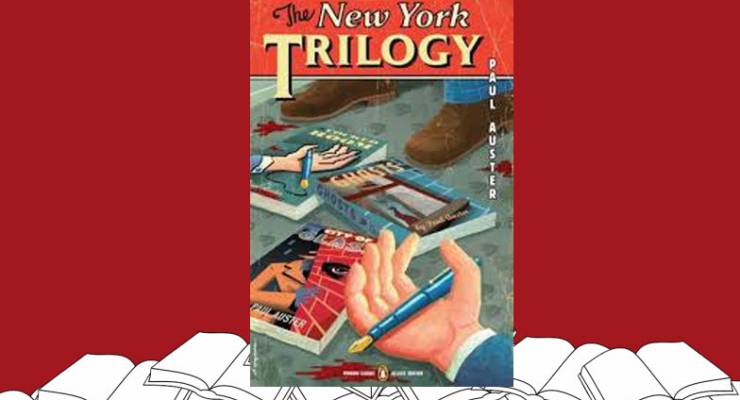
Sacred Cows is a series dedicated to overrated cultural artefacts and the more deserving ones we’ve lost sight of in their shadows. Each installment will pose an argument for one or the other, re-evaluating the worth of a text and the praise it has (or hasn’t) received.
This week, David Latham makes the case for Paul Auster’s New York Trilogy.
Shortly after the economic Golden Age had drawn to a close in the mid ’70s and modernity started to take on what Zygmunt Bauman described as its unstable, liquid form, Paul Auster wrote New York Trilogy — a collection of stories that reflected this changed world, and transformed expectations of what high-concept literature and detective fiction might deliver. Rather than writing about hard-boiled pros investigating some external menace, Auster’s amateur detectives are introspective narrators: the cases under investigation are not crimes but our certitude about life and what we think we know.
Originally released as three separate books in 1985 and 1986, the stories — City of Glass, Ghosts and The Locked Room — were well received critically, but Auster himself was not so sure about their literary value, likening their popularity to Lou Reed’s hackneyed “Walk on the Wild Side” or Godard’s Breathless, sacred cows not particularly loved by their creators. But despite Auster’s disparagement of his own work, there’s no do doubt it signalled an interesting direction in the evolution of literature
However, there are two things Auster vehemently denies about New York Trilogy. The first is that these are detective stories; in spite of the fact that two of the stories’ protagonists are engaged in paid detective work, and the third is involved in an investigation. The second is that this is postmodern literature. And looking at the form a bit closer, I might be inclined to believe him.
The detective novel is a genre type not typically associated with philosophical and psycho-social investigations. A Victorian-era or mid-century pulp fiction novel tends to operate like a pencil sharpener; the detective shaving away the superfluous elements of the story until the sharp nub of facts are revealed.
By way of contrast, Auster’s amateur detectives telescope out. The closer they try to get to their object of contemplation the more it recedes into the distance or becomes a meaningless blur.
The facts of the matter remain elusive; to a large degree because the protagonist is clouded in mystery, to themselves and the reader; until their motives and sense of self are obliterated. The subject of investigation disappears and suddenly they become the object. The world understood as a log of facts or meaningful patterns fails; language is ambiguous; the “I” is subverted.
For this reason many people consider New York Trilogy to be a piece of postmodern fiction. Yes, theorists like Kuhn, Derrida and Foucault can spring to mind when reading, but it’s better understood as a piece of literary modernism. Gogol, Dostoyevsky, Beckett, Breton are maybe better guides for what’s going on here.
It might almost be described as nihilistic if it weren’t so funny. The way Auster’s purposefully earnest and faux naïve writing style interacts with the genre had me in silent convulsions a few times on the train. The fulsome exposition of genre conventions is often hilarious, for example when the protagonist of the second story, Blue (an incognito detective), waxes boyish when speaking to a detective, Black, in a bar:
Cracking cases, living by your wits, seducing women, pumping guys full of lead — God, there’s a lot to be said for it.
Blue is being paid to watch Black, who in turn is watching someone else to no purpose, like an Escher drawing — or images reflected forever and leading to nowhere.
This disorientation continues in the other stories. In City of Glass, author Dan Quinn is drawn into a detective case before mentally unravelling as Auster investigates religio-philosophical concerns (man and the fall) and literary interests (Don Quixote, Paradise Lost). The Locked Room, written in first person, follows an unknown narrator as he inhabits the life of a former high-school friend and literary talent who everyone else thinks is dead.
The stories are self-reflexive, but not in an unbearable, Gravity’s Rainbow sort of way — a book whose architecture is designed to irritate. These stories fulfill an admirable and sometimes scarce literary function: the entertainment of the reader.








David, it’s great to see some lit crit here in Crikey’s hoary electropages. Thank you for contributing.
I’d agree with Auster that the New York Trilogy isn’t readily recognisable as detective genre fiction. A genre usually has both a literary signature (which we might think of as being a particular class of subject exposed a particular way), and a sociological signature (which we might think of as an auctorial/readerly community of interest in subject and method who therefore pay attention to one another.)
I think it’d be fair to say that detective fiction typically focuses on exploring the price of justice through whodunnit or whydunnit investigation (your ‘pencil-sharpening’ metaphor is apposite), and its fans tend to recognise authors like Doyle, Christie, Chandler, Sayers, Leonard, Elroy, Paretsky, Patterson, Rankin, Larsson, and so on. The detective novel typically reads like an investigative adventure — some Campbellian Hero’s Journey into illicit means, motive and timeline that transforms its central characters morally and socially.
I certainly didn’t get much sense of the price of justice as a central theme in Auster; I agree that the novels (or those I read, since it was a long while ago) were reflective and almost confessional rather than investigative adventures; and while I haven’t tested it, I’d be surprised if many self-professed detective genre fans would recognise Auster among their favourite genre authors. That didn’t stop City of Glass from getting an Edgar nomination, but awards aren’t authoritative in themselves. Good genre authors always read more broadly than they write, and genre readers may not follow all their readings. I think calling Auster a detective novelist for the New York Trilogy would be like calling Ian McEwan a travel novelist for The Comfort of Strangers and On Chessel Beach.
While you could argue it either way, I’m inclined to agree with you that the New York Trilogy is modernism: a literary reuse of genre elements in new ways to explore a different topic. You could cite Joyce’s Ulysses as an early precedent for this (and later authors have done it too.) But critics argue over the postmodernism of Joyce; I can see why they might argue over Auster. It’ll never be other than a rarified discussion though.
I think readers who enjoy Auster are likely to laud his darkly humorous and well-constructed narrative; his essay-like reflections; and his departure from detective genre tropes. Readers who don’t like Auster may complain about nearly the same: his rambling narrative, lack of central focus and reflective indulgence at the expense of incident and tempo. Since that’s a matter of taste, I can’t see why there’s a ‘should’ on either side, and you didn’t really explain why there is — were you just trying to provoke?
Yet I’d agree that readers interested in the development of the novel should know about Auster, while readers interested in detective genre fiction should know about the shadows beyond the firelight — and I’d certainly place Auster there. I don’t personally view this trilogy as a sacred cow though. For all the critical attention it received, how many subsequent authors — especially in the detective genre — have borrowed any of Auster’s methods and devices? Auster undoubtedly has reach — especially beyond the genre — but in the end, what is his impact? (An open question rather than a rhetorical one: you might have a view on this; I don’t.)
It’s delightful to see the discussion here though, David. I’m often surprised by how well and broadly read are the Crikelings. I’m sorry to have missed your earlier contributions, but May and June were busy and at times very stressful for me. Good luck with the series!